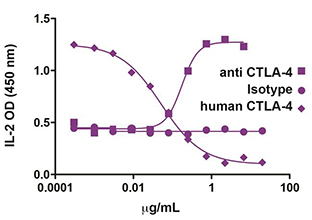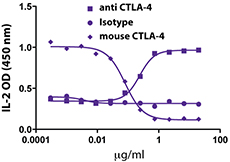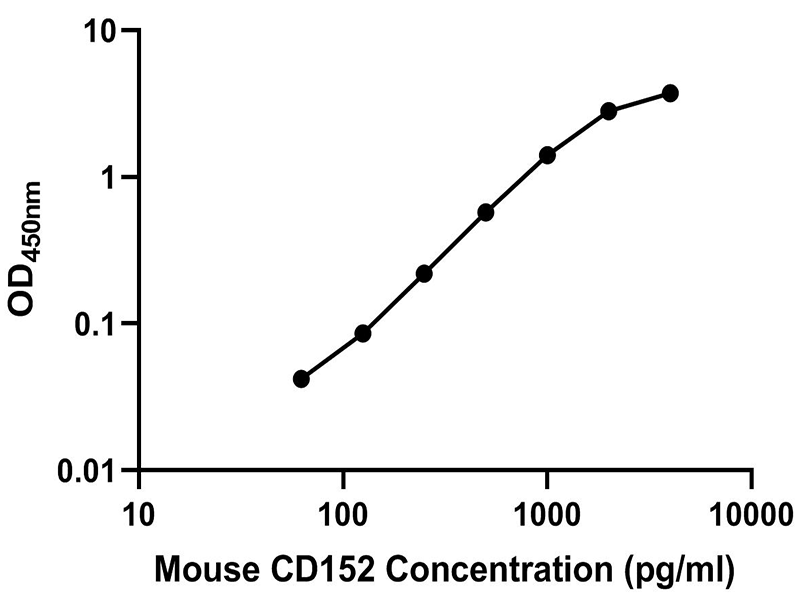- Clone
- BNI3 (See other available formats)
- Regulatory Status
- RUO
- Other Names
- CTLA4, Cytotoxic T-Lymphocyte Antigen 4, CTLA-4
- Isotype
- Mouse IgG2a, κ
- Ave. Rating
- Submit a Review
- Product Citations
- publications

-

Human peripheral blood mononuclear cells were stimulated with Cell Activation Cocktail (without brefeldin) for 4 hours, surface stained with CD3 APC, fixed, permeabilized, and intracellularly stained with CD152 (CTLA-4) (clone BNI3) PE/Dazzle™ 594 (left), or mouse IgG2a, κ PE/Dazzle™ 594 isotype control (right). -

PHA-stimulated human peripheral blood mononuclear cells (3 days) were stained with CD3 APC and anti-human CD152 (clone BNI3) PE/Dazzle™ 594 (left), or mouse IgG2a, κ PE/Dazzle™ 594 isotype control (right).
| Cat # | Size | Price | Quantity Check Availability | Save | ||
|---|---|---|---|---|---|---|
| 369615 | 25 tests | 128€ | ||||
| 369616 | 100 tests | 296€ | ||||
CD152, also known as Cytotoxic T-Lymphocyte Antigen 4 (CTLA-4), is a 33 kD member of the immunoglobulin superfamily. It is transiently expressed on activated T cells. CTLA-4 is expressed on the surface of helper T cells and transmits an inhibitory signal to T cells. Regulatory T cells express high levels of CTLA-4. CTLA-4 (CD152) is similar to CD28 in amino acid sequence, structure, and genomic organization. Whereas CD28 delivers a costimulatory signal in T cell activation, CTLA-4 negatively regulates cell-mediated immune responses through interaction with CD80 (B7-1) and CD86 (B7-2) present on antigen presenting cells (APC). CTLA-4 is thought to play a role in the induction and maintenance of immunological tolerance as well as the development of protective immunity and thymocyte regulation.
Mutations in the CTLA-4 gene have been associated with various autoimmune diseases, such as systemic lupus erythematosus, insulin-dependent diabetes mellitus, and other autoimmune diseases. A transcript of the CTLA-4 gene that may represent a native soluble form of CTLA-4 (sCTLA-4) showed that eleven of twenty patients with autoimmune thyroid disease (ATD) had a high concentration of sCTLA-4, whereas only 1 of 30 apparently healthy volunteers contained measurable levels. sCTLA-4 immunoreactivity was inhibited by its binding to B7.1, suggesting that sCTLA-4 is a functional receptor. sCTLA-4 also plays a role in the initial immune response to infection of immune cells by HIV, along with the CD-1 pathway and others.
Product Details
- Verified Reactivity
- Human
- Antibody Type
- Monoclonal
- Host Species
- Mouse
- Immunogen
- Extracellular domain of human CTLA-4 and constant regions of the human IgG heavy chain (CTLA-4/IgG)
- Formulation
- Phosphate-buffered solution, pH 7.2, containing 0.09% sodium azide and BSA (origin USA)
- Preparation
- The antibody was purified by affinity chromatography and conjugated with PE/Dazzle™ 594 under optimal conditions.
- Concentration
- Lot-specific (to obtain lot-specific concentration and expiration, please enter the lot number in our Certificate of Analysis online tool.)
- Storage & Handling
- The antibody solution should be stored undiluted between 2°C and 8°C, and protected from prolonged exposure to light. Do not freeze.
- Application
-
ICFC - Quality tested
FC - Verified - Recommended Usage
-
Each lot of this antibody is quality control tested by intracellular immunofluorescent staining with flow cytometric analysis. For flow cytometric staining, the suggested use of this reagent is 5 µL per million cells in 100 µL staining volume or 5 µL per 100 µL of whole blood. For flow cytometric staining, the suggested use of this reagent is 5 µL per million cells in 100 µL staining volume or 5 µL per 100 µL of whole blood. It is recommended that the reagent be titrated for optimal performance for each application.
* PE/Dazzle™ 594 has a maximum excitation of 566 nm and a maximum emission of 610 nm. - Excitation Laser
-
Blue Laser (488 nm)
Green Laser (532 nm)/Yellow-Green Laser (561 nm)
- Application Notes
-
Based on in-house testing, we do not recommend using clone BNI3 for immunohistochemistry of paraffin-embedded tissue section.
- Application References
-
- Linsley PS, et al. 1992. J. Exp. Med. 176:1595.
- Bonzheim I, et al. 2008. Am. J. Clin. Pathol. 130:613.
- Product Citations
-
- RRID
-
AB_2632877 (BioLegend Cat. No. 369615)
AB_2632878 (BioLegend Cat. No. 369616)
Antigen Details
- Structure
- Ig superfamily and 33 kD.
- Distribution
-
Activated T cells and B cells.
- Function
- Negative regulator of T cell activation.
- Interaction
- Antigen presenting cells, such as dendritic cells.
- Ligand/Receptor
- B7-1 (CD80), B7-2 (CD86).
- Cell Type
- B cells, T cells
- Biology Area
- Immunology, Inhibitory Molecules
- Molecular Family
- CD Molecules, Immune Checkpoint Receptors
- Antigen References
-
1. Kuiper HM, et al. 1995. J. Immunol. 155:1776.
2. Castan J, et al. 1997. Immunology 90:265.
3. Lee CC, et al. 2009. Pediatr. Allergy Immunol. 20:624.
4. Pistillo MP, et al. 2003. Blood 101:202.
5. Tan PH, et al. 2005. Blood. 106:2936.
6. Steiner K, et al. 2001. Clin. Exp. Immunol. 126:143. - Gene ID
- 1493 View all products for this Gene ID
- UniProt
- View information about CD152 on UniProt.org
Related FAQs
Other Formats
View All CD152 Reagents Request Custom ConjugationCustomers Also Purchased
Compare Data Across All Formats
This data display is provided for general comparisons between formats.
Your actual data may vary due to variations in samples, target cells, instruments and their settings, staining conditions, and other factors.
If you need assistance with selecting the best format contact our expert technical support team.
-
Purified anti-human CD152 (CTLA-4)

Human peripheral blood mononuclear cells were stimulated wit... 
PHA-stimulated human peripheral blood mononuclear cells (day... -
PE anti-human CD152 (CTLA-4)

Human peripheral blood mononuclear cells were stimulated wit... 
PHA-stimulated human peripheral blood mononuclear cells (day... -
Brilliant Violet 421™ anti-human CD152 (CTLA-4)

Human peripheral blood mononuclear cells were stimulated wit... 
PHA-stimulated human peripheral blood mononuclear cells (3 d... -
Brilliant Violet 605™ anti-human CD152 (CTLA-4)

Human peripheral blood mononuclear cells were stimulated wit... 
PHA-stimulated human peripheral blood mononuclear cells (3 d... -
PerCP/Cyanine5.5 anti-human CD152 (CTLA-4)

PHA-stimulated human peripheral blood mononuclear cells (day... 
-
Biotin anti-human CD152 (CTLA-4)

Human peripheral blood mononuclear cells were stimulated wit... 
PHA-stimulated human peripheral blood mononuclear cells (3 d... -
APC anti-human CD152 (CTLA-4)

Human peripheral blood mononuclear cells were stimulated wit... 
PHA-stimulated human peripheral blood mononuclear cells (3 d... -
PE/Cyanine7 anti-human CD152 (CTLA-4)

Human peripheral blood mononuclear cells were stimulated wit... 
PHA-stimulated human peripheral blood mononuclear cells (3 d... -
PE/Dazzle™ 594 anti-human CD152 (CTLA-4)

Human peripheral blood mononuclear cells were stimulated wit... 
PHA-stimulated human peripheral blood mononuclear cells (3 d... -
TotalSeq™-A0151 anti-human CD152 (CTLA-4)
-
TotalSeq™-C0151 anti-human CD152 (CTLA-4)
-
Brilliant Violet 785™ anti-human CD152 (CTLA-4)

Human peripheral blood mononuclear cells were stimulated wit... 
Cell Activation Cocktail-stimulated Human peripheral blood m... -
TotalSeq™-B0151 anti-human CD152 (CTLA-4)
-
APC/Fire™ 750 anti-human CD152 (CTLA-4)

Cell Activation Cocktail (without brefeldin)-stimulated Huma... -
Alexa Fluor® 647 anti-human CD152 (CTLA-4)

Cell Activation Cocktail (w/o brefeldin)-stimulated human pe... -
APC/Cyanine7 anti-human CD152 (CTLA-4) Antibody

Cell Activation Cocktail (without brefeldin)-stimulated huma... -
Brilliant Violet™ 711 anti-human CD152 (CTLA-4)

Human peripheral blood mononuclear cells were stimulated wit... -
TotalSeq™-D0151 anti-human CD152 (CTLA-4)
-
PE/Fire™ 640 anti-human CD152 (CTLA-4)

Human peripheral blood mononuclear cells were stimulated (le... 
Human peripheral blood mononuclear cells stimulated (3 days)... -
Spark Red™ 718 anti-human CD152 (CTLA-4)

Human peripheral blood mononuclear cells were stimulated wit... -
PE/Cyanine5 anti-human CD152 (CTLA-4)

Human peripheral blood mononuclear cells were stimulated wit... -
PE/Fire™ 744 anti-human CD152 (CTLA-4)

Human peripheral blood mononuclear cells were stimulated wit...
 Login / Register
Login / Register 


















Follow Us